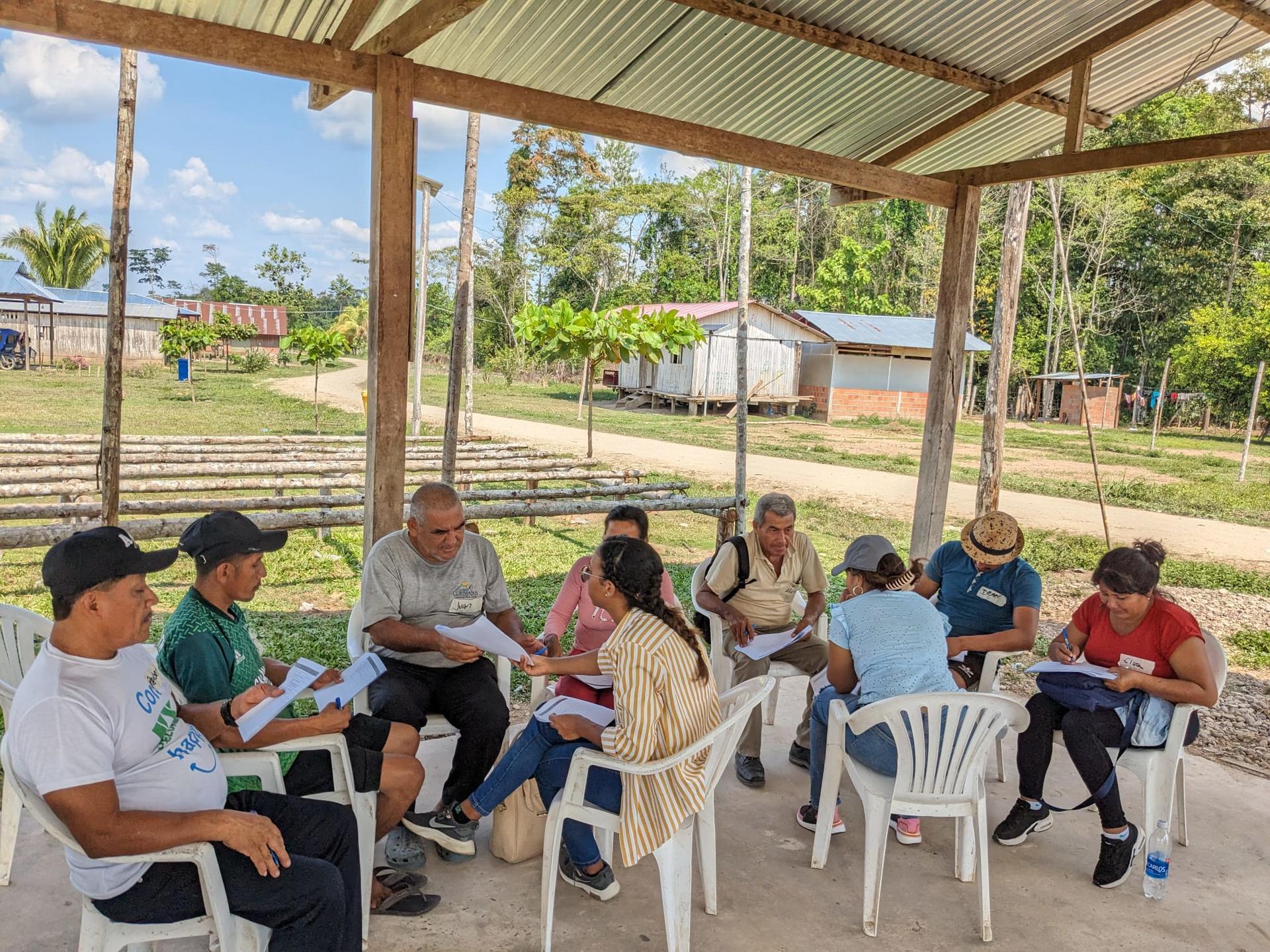Blog How to integrate Agroecological Principles into Peru's Cacao Business Model for Sustainable and Resilient Agriculture

This blog explores how Peruvian cacao farmers naturally integrate agroecological principles into their production, shedding light on the path towards resilient food systems.
By: Diego Crisostomo, Maria Blanco, Leslie E. Mosquera, Thea Ritter, and Jonathan Mockshell
As part of the Private Sector Incentives and Investments (PSii) project contributing to the Agroecological Transitions program for building resilient and inclusive agricultural and food systems food systems (TRANSITIONS), a fieldwork expedition in the province of Padre Abad in the Ucayali region of Peru was carried out by the research team. The fieldwork aims at examining how farmers in the Curimaná Agrarian Cooperative integrate agroecological principles into their business models in the cacao value chain.
Increasingly, agroecology is recognized as an effective means of transitioning towards sustainable food systems. Agroecology is defined as the application of ecological concepts and principles in farming to optimize interactions among plants, animals, humans, and the environment, while considering the social aspects necessary for a sustainable and equitable food system. Its goal is to increase output while minimizing the use of external inputs and maximizing the utilization of natural resources. This approach is based on 13 agroecological principles that encompass everything from input reduction to land and natural resource governance, as well as social participation (Mockshell et al., 2023).
Table 1: Thirteen agroecological principles, from (HLPE, 2019; Jones et al., 2022)
Agroecological principle (short name in bold) |
|
Improve resource efficiency |
|
Principle 1: Recycling, ideally local renewable resources, and closing nutrient and biomass cycles. |
|
Principle 2: Reduction of inputs by prioritizing self-sufficiency and limiting or eliminating environmentally harmful chemicals and inputs. |
|
Strengthen resilience |
|
Principle 3: Improve soil health by managing organic matter and improving biological activity. |
|
Principle 4: Ensuring animal health and welfare |
|
Principle 5: Preserve and enhance the overall biodiversity of agroecosystems through time and space at the field, farm, and landscape scales. |
|
Principle 6: Enhance synergies among the components of agroecosystems (animals, crops, trees, soil, and water). |
|
Principle 7: Economic diversification aims to enhance financial autonomy and create more options for value creation, while also enabling the ability to meet customer demands. |
|
Secure social equity/responsibility |
|
Principle 8: Co-creation of knowledge and horizontal exchange, including local and scientific innovation, especially through farmer-to-farmer exchange. |
|
Principle 9: Respect social values and diets by establishing food systems based on local communities' culture, identity, tradition, and social and gender equity that provide nutritious, diverse, seasonal, and culturally acceptable diets. |
|
Principle 10: Promote fairness by ensuring that all actors in the food system have respectable and sustainable livelihoods based on fair trade, safe and dignified working conditions, and fair intellectual property rights. |
|
Principle 11: Enhance the level of connectivity between producers and consumers by advocating for the development of local marketplaces and equitable distribution networks. |
|
Principle 12: Land and natural resource governance. Enhance the institutional frameworks to acknowledge and support smallholders and indigenous peoples as effective managers of sustainable natural and genetic resources. |
|
Principle 13: Promote and enable the participation of food producers and consumers, especially women, youth, and minority groups, in the process of making decisions. |
Transition pathways require the adoption and expansion of agroecological principles. However, this transition to agroecological systems involves government and private sector incentives and investments to encourage behavioral change and transform food systems.
Figure 1: Incentive types, agroecological practices, and outcomes.
Source: Mockshell et al., 2023.
To examine agroecological practices in the cacao value chain in Peru, fieldwork was conducted through four focus discussion group discussions in four villages (Curimana, Nueva Alianza, Dos de Mayo, and Nuevo Amazonas) with a total of 37 farmers from a cooperative. Based on these discussions, two methods were applied to examine the results. First, the Canvas methodology was applied to understand linkages between cacao producers and buyers – a key component of the cacao value chain. In addition, an assessment was made of how farmers adapt practices to meet customer needs. Second, based on the current understanding of agroecological principles (Mockshell et al., 2023), we examined farmers' applications of agroecological principles in their business models.

Photo 2: Focus group discussion group in Caserio Nueva Alianza
We found that despite most farmers being unfamiliar with the concepts of 'agroecological principles' and 'incentives,' they were already instinctively applying numerous agroecological principles in their agricultural practices. For example, one of the most intriguing findings was to see that most of the farmers reused their crop residues to make fertilizers, thereby applying the agroecological principle of recycling. In addition, many farmers set aside part of their land for forest preservation by planting forest species, such as Bolaina, Capirona and Cedar, and/or use part of their land for the production of other crops, such as cassava, plantain, and corn. These activities show how farmers are applying the agroecological principle of biodiversity. Before their adoption, these agroecological practices were introduced by the cooperative's technicians, state programs, and NGOs.
Another interesting finding is that farmers adopted incentives. For example, all farmers were part of an agricultural cooperative and received technical assistance from the cooperative (non-market incentive) and the cooperative was organically certified (a regulatory incentive). However, some farmers suggested that the introduction of agricultural technologies, such as drip irrigation systems and the provision of organic fertilizers, as well as improved cocoa prices could serve as valuable stimuli for the transition to applying more agroecological practices. In addition, most lacked knowledge about compensation programs for environmental services and sustainability certifications.
The Team

Jonathan Mockshell
Scientist and Project Leader
Maria Blanco
Research associate
Leslie Estefany Mosquera Escobar
Research AssociateThe fieldwork unveiled the application of some agroecological principles in the cocoa value chain in Peru, as well as farmers' willingness to adopt more sustainable practices. These findings underscore the importance of coordinating policies, investments, technical assistance, and awareness to support the transition to agroecological food systems in Peru.
Acknowledgment: The Agroecological Transitions for Building Resilient, Inclusive, Agricultural and Food Systems (TRANSITIONS) Program is funded by the European Union through its DeSIRA initiative and managed by the International Fund for Agricultural Development (IFAD). The TRANSITIONS Private Sector Incentives and Investments (PSii) project aims at the development of inclusive incentive structures for private sector and private-public stakeholders, as well as leveraging investments supporting agroecological transitions at multiple levels. The contents and opinions expressed in this publication are not peer reviewed and are the sole responsibility of the authors. They do not necessarily reflect the views of the European Union, IFAD or affiliated organizations.
